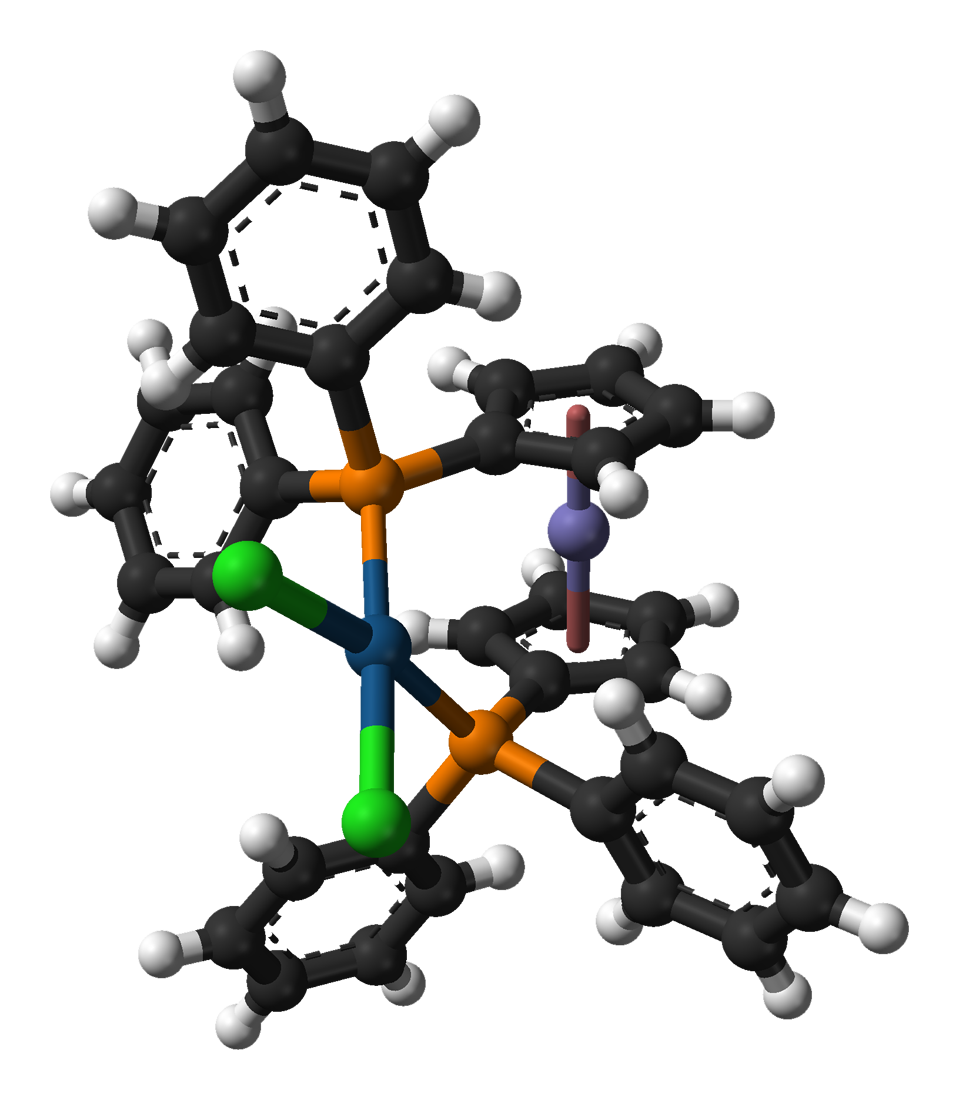1,1'-bis(diphenylphosphino)ferrocene on:
[Wikipedia]
[Google]
[Amazon]
1,1-Bis(diphenylphosphino)ferrocene, commonly abbreviated dppf, is an organophosphorus compound commonly used as a
 Another example of dppf in homogeneous catalysis is provided by the air- and moisture-stable Ni(II) precatalyst dppf)Ni(cinnamyl)Cl. It promotes Suzuki-Miyuara cross-coupling of heteroaryl boronic acids with nitrogen- and sulfur-containing heteroaryl halides.
Another dppf-based catalyst is (dppf)Ni(''o''-tolyl)Cl, can be prepared from ligand exchange with (PPh3)2Ni(''o''-tolyl)Cl. It promotes the amination of aryl chlorides, sulfamates, mesylates, and triflates.
Another example of dppf in homogeneous catalysis is provided by the air- and moisture-stable Ni(II) precatalyst dppf)Ni(cinnamyl)Cl. It promotes Suzuki-Miyuara cross-coupling of heteroaryl boronic acids with nitrogen- and sulfur-containing heteroaryl halides.
Another dppf-based catalyst is (dppf)Ni(''o''-tolyl)Cl, can be prepared from ligand exchange with (PPh3)2Ni(''o''-tolyl)Cl. It promotes the amination of aryl chlorides, sulfamates, mesylates, and triflates.
ligand
In coordination chemistry, a ligand is an ion or molecule ( functional group) that binds to a central metal atom to form a coordination complex. The bonding with the metal generally involves formal donation of one or more of the ligand's elec ...
in homogeneous catalysis
In chemistry, homogeneous catalysis is catalysis by a soluble catalyst in a solution. Homogeneous catalysis refers to reactions where the catalyst is in the same phase as the reactants, principally in solution. In contrast, heterogeneous catalysi ...
. It contains a ferrocene moiety in its backbone, and is related to other bridged diphosphines
Diphosphines, sometimes called bisphosphanes, are organophosphorus compounds most commonly used as bidentate phosphine ligands in inorganic and organometallic chemistry. They are identified by the presence of two phosphino groups linked by a bac ...
such as 1,2-bis(diphenylphosphino)ethane
1,2-Bis(diphenylphosphino)ethane (dppe) is an organophosphorus compound with the formula (PhPCH) (Ph = phenyl). It is a commonly used bidentate ligand in coordination chemistry. It is a white solid that is soluble in organic solvents.
Preparat ...
(dppe).
Preparation
This compound is commercially available. It may be prepared by treatingdilithioferrocene
1,1'-Dilithioferrocene is the organoiron compound with the formula Fe(C5H4Li)2. It is exclusively generated and isolated as a solvate, using either ether or tertiary amine ligands bound to the lithium centers. Regardless of the solvate, dilithiof ...
with chlorodiphenylphosphine
Chlorodiphenylphosphine is an organophosphorus compound with the formula (C6H5)2PCl, abbreviated Ph2PCl. It is a colourless oily liquid with a pungent odor that is often described as being garlic-like and detectable even in the ppb range. It is u ...
:
:Fe(CHLi) + 2 ClPPh → Fe(CHPPh) + 2 LiCl
The dilithiation of ferrocene is easily achieved with ''n''-butyllithium in the presence of TMEDA. Many related ligands can be made in this way. The Fe center is typically not involved in the behavior of the ligand.
Reactions
Dppf readily forms metal complexes. The palladium derivative, (dppf)PdCl, which is popular forpalladium-catalyzed coupling reactions
In organic chemistry, a cross-coupling reaction is a reaction where two fragments are joined together with the aid of a metal catalyst. In one important reaction type, a main group organometallic compound of the type R-M (R = organic fragment, M = ...
, is prepared by treating dppf with the acetonitrile or benzonitrile adducts of palladium dichloride
Palladium(II) chloride, also known as palladium dichloride and palladous chloride, are the chemical compounds with the formula PdCl2. PdCl2 is a common starting material in palladium chemistry – palladium-based catalysts are of particular value ...
: Substitution of the phenyl substituents in dppf leads to derivatives with modified donor-acceptor properties at the phosphorus atoms.
:dppf + PdCl(RCN) → (dppf)PdCl + 2 RCN (RCN = acetonitrile or benzonitrile
Benzonitrile is the chemical compound with the formula , abbreviated PhCN. This aromatic organic compound is a colorless liquid with a sweet bitter almond odour. It is mainly used as a precursor to the resin benzoguanamine.
Production
It is p ...
)
 Another example of dppf in homogeneous catalysis is provided by the air- and moisture-stable Ni(II) precatalyst dppf)Ni(cinnamyl)Cl. It promotes Suzuki-Miyuara cross-coupling of heteroaryl boronic acids with nitrogen- and sulfur-containing heteroaryl halides.
Another dppf-based catalyst is (dppf)Ni(''o''-tolyl)Cl, can be prepared from ligand exchange with (PPh3)2Ni(''o''-tolyl)Cl. It promotes the amination of aryl chlorides, sulfamates, mesylates, and triflates.
Another example of dppf in homogeneous catalysis is provided by the air- and moisture-stable Ni(II) precatalyst dppf)Ni(cinnamyl)Cl. It promotes Suzuki-Miyuara cross-coupling of heteroaryl boronic acids with nitrogen- and sulfur-containing heteroaryl halides.
Another dppf-based catalyst is (dppf)Ni(''o''-tolyl)Cl, can be prepared from ligand exchange with (PPh3)2Ni(''o''-tolyl)Cl. It promotes the amination of aryl chlorides, sulfamates, mesylates, and triflates.
See also
*Diphosphines
Diphosphines, sometimes called bisphosphanes, are organophosphorus compounds most commonly used as bidentate phosphine ligands in inorganic and organometallic chemistry. They are identified by the presence of two phosphino groups linked by a bac ...
* borrowing hydrogen
Hydrogen auto-transfer, also known as borrowing hydrogen, is the activation of a chemical reaction by temporary transfer of two hydrogen atoms from the reactant to a catalyst and return of those hydrogen atoms back to a reaction intermediate to fo ...
catalysis
References
{{DEFAULTSORT:Bisdiphenylphosphinoferrocene, 1, 1'- Ferrocenes Tertiary phosphines Diphosphines